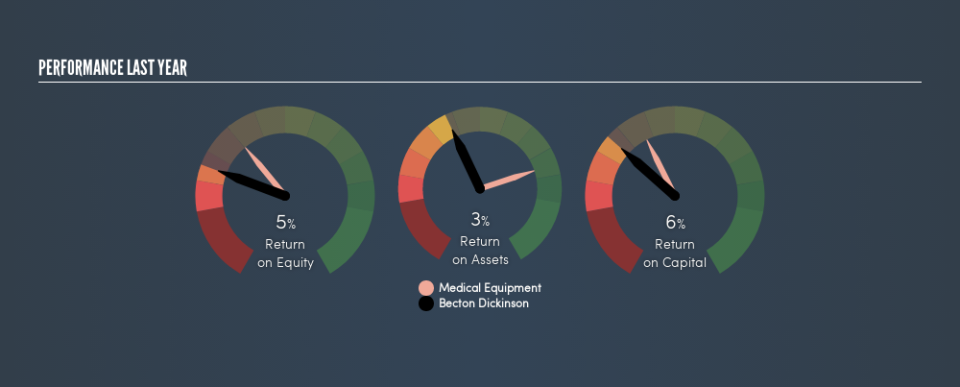Here’s why Becton, Dickinson and Company’s (NYSE:BDX) Returns On Capital Matters So Much

Want to participate in a research study? Help shape the future of investing tools and earn a $60 gift card!
Today we'll evaluate Becton, Dickinson and Company (NYSE:BDX) to determine whether it could have potential as an investment idea. In particular, we'll consider its Return On Capital Employed (ROCE), as that can give us insight into how profitably the company is able to employ capital in its business.
First of all, we'll work out how to calculate ROCE. Second, we'll look at its ROCE compared to similar companies. Finally, we'll look at how its current liabilities affect its ROCE.
What is Return On Capital Employed (ROCE)?
ROCE is a metric for evaluating how much pre-tax income (in percentage terms) a company earns on the capital invested in its business. In general, businesses with a higher ROCE are usually better quality. Overall, it is a valuable metric that has its flaws. Renowned investment researcher Michael Mauboussin has suggested that a high ROCE can indicate that 'one dollar invested in the company generates value of more than one dollar'.
So, How Do We Calculate ROCE?
The formula for calculating the return on capital employed is:
Return on Capital Employed = Earnings Before Interest and Tax (EBIT) ÷ (Total Assets - Current Liabilities)
Or for Becton Dickinson:
0.062 = US$2.8b ÷ (US$53b - US$7.1b) (Based on the trailing twelve months to December 2018.)
So, Becton Dickinson has an ROCE of 6.2%.
Check out our latest analysis for Becton Dickinson
Is Becton Dickinson's ROCE Good?
ROCE is commonly used for comparing the performance of similar businesses. Using our data, Becton Dickinson's ROCE appears to be significantly below the 11% average in the Medical Equipment industry. This performance is not ideal, as it suggests the company may not be deploying its capital as effectively as some competitors. Aside from the industry comparison, Becton Dickinson's ROCE is mediocre in absolute terms, considering the risk of investing in stocks versus the safety of a bank account. It is possible that there are more rewarding investments out there.
As we can see, Becton Dickinson currently has an ROCE of 6.2%, less than the 8.8% it reported 3 years ago. This makes us wonder if the business is facing new challenges.
Remember that this metric is backwards looking - it shows what has happened in the past, and does not accurately predict the future. ROCE can be deceptive for cyclical businesses, as returns can look incredible in boom times, and terribly low in downturns. ROCE is only a point-in-time measure. Future performance is what matters, and you can see analyst predictions in our free report on analyst forecasts for the company.
What Are Current Liabilities, And How Do They Affect Becton Dickinson's ROCE?
Current liabilities are short term bills and invoices that need to be paid in 12 months or less. Due to the way ROCE is calculated, a high level of current liabilities makes a company look as though it has less capital employed, and thus can (sometimes unfairly) boost the ROCE. To check the impact of this, we calculate if a company has high current liabilities relative to its total assets.
Becton Dickinson has total assets of US$53b and current liabilities of US$7.1b. As a result, its current liabilities are equal to approximately 13% of its total assets. This very reasonable level of current liabilities would not boost the ROCE by much.
The Bottom Line On Becton Dickinson's ROCE
With that in mind, we're not overly impressed with Becton Dickinson's ROCE, so it may not be the most appealing prospect. Of course you might be able to find a better stock than Becton Dickinson. So you may wish to see this free collection of other companies that have grown earnings strongly.
If you like to buy stocks alongside management, then you might just love this free list of companies. (Hint: insiders have been buying them).
We aim to bring you long-term focused research analysis driven by fundamental data. Note that our analysis may not factor in the latest price-sensitive company announcements or qualitative material.
If you spot an error that warrants correction, please contact the editor at editorial-team@simplywallst.com. This article by Simply Wall St is general in nature. It does not constitute a recommendation to buy or sell any stock, and does not take account of your objectives, or your financial situation. Simply Wall St has no position in the stocks mentioned. Thank you for reading.

 Yahoo Finance
Yahoo Finance 
